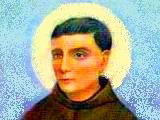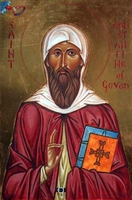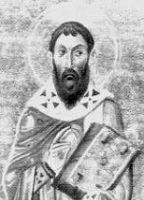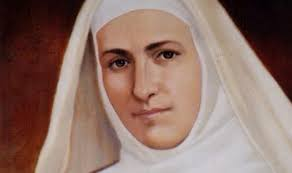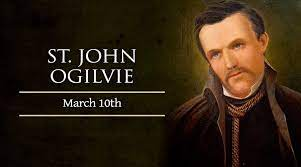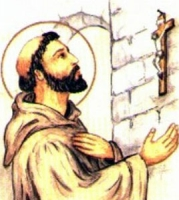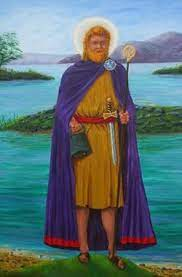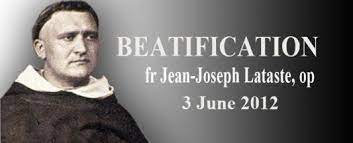St. Teresa Kinn-Tsie
Death: 1900
Canonized: Pope John Paul II
Chinese Martyrs (traditional Chinese: 中華聖烈士; simplified Chinese: 中华圣烈士; pinyin: Zhōnghuá shéng lièshì; Wade–Giles: Chung1-hua2 shêng4-lieh4-shih4) is the name given to a number of members of the Catholic Church and the Eastern Orthodox Church who were killed in China during the 19th and early 20th centuries. They are celebrated as martyrs by their respective churches. Most were Chinese laity, but others were missionaries from various other countries; many of them died during the Boxer Rebellion.
Blessed Frano Gjini
Profile
Ordained a priest in the diocese of Shkodrë, Albania on 28 June 1908. Vicar-general of the archdiocese of Durrës, Albania in 1918. Parish priest in Durrës, Derven of Fushë Krujë, Kurbin and Perlat of Kthella, Albania at different times. Chosen abbot of the Abbey Nullius of Saint Lelezhdri of Orosh in Mirdita on 29 June 1930. Consecrated titular bishop of Semta on 28 October 1930. Chosen apostolic delegate to Albania on 11 November 1945 after the previous delegate was not permitted back into the country. Chosen bishop of Lezhë, Albania on 4 January 1946. He was arrested by Communist authorities in Shkodrë on 15 November 1946 for continuing to work for the Church, sentenced to death on 8 January 1948 and executed. Martyr.
Born
20 February 1886 in Shkodër, Albania
Died
shot on 11 March 1948 in Shkodër, Albania
Beatified
• 5 November 2016 by Pope Francis
• beatification celebrated at the Square of the Cathedral of Shën Shtjefnit, Shkodër, Albania, presided by Cardinal Angelo Amato
Saint Alexius U Se-Yong
Also known as
• Alejo U Se-yong
• Alessio U Se-yong
• Alleksio
• U Se-Yeong
Additional Memorial
20 September as one of the Martyrs of Korea
Profile
Young layman, born to the wealthy nobility in the apostolic vicariate of Korea. Having become interested in Christianity, he met with Saint Siméon-François Berneux, and Saint Marcus Chong Ui-Bae served as his catechist. Convert. His family was strongly opposed to Christianity, and Alexius left home to work with missionaries, translating the Catechism and other texts to Korean.
During one of the repeated persecutions, all Christians in his village were arrested. Alexius gave in to his fears and denied the faith, and was released. He then repented and went to prison to confess his failure to his bishop. He was then arrested, imprisoned with the others, tortured, and finally executed for his faith. Martyr.
Born
1845 in Seoheung, Hwanghae-do, North Korea
Died
11 March 1866 at the Small West Gate, Seoul, South Korea
Canonized
6 May 1984 by Pope John Paul II
Saint Marcus Chong Ui-Bae
Also known as
• Jeong Eui-Bae
• Mareuko
Additional Memorial
20 September as one of the Martyrs of Korea
Profile
Raised in a pagan family, he became a teacher. He married but was a widower with no children. He became interested in Christianity when he saw the calm with which two priests met their martyrdom. He began studying, read himself into the faith, and converted. He served as a catechist; among others, he helped bring Saint Alexius U Se-Yong to the faith; and spent his free time caring for orphans and visiting the sick. During one of the periodic persecutions of Christians, he was given a chance to leave the country, but stayed to help those who could not leave. He was seized, insulted, abused and beaten by his neighbors and his own family members for his faith, then turned over to government officials for execution. Martyr.
Born
1795 in Yongin, Gyeonggi-do, South Korea
Died
11 March 1866 at the Small West Gate, Seoul, South Korea
Canonized
6 May 1984 by Pope John Paul II
Blessed Dedë Nikaj
Also known as
• Brother Ciprian
• Dedë Nikacj
Profile
Orphaned at age five, he was educated by the Franciscans. Studied in Shkodër, Albania, then Lankowitz and Graz in Austria, then in Rome, Italy. Ordained a priest in Rome on 25 July 1924. Taught at a Franciscan seminary from 1929 to 1932. Novice master from 1932 to 1938. Franciscan provincial master from 1938 to 1941. Director of the Franciscan seminary from 1941 to 1944. Franciscan Guardian of Gjuhadol in 1944. On 15 November 1946 the Communist authorities arrested him on a charge of concealing weapons behind a church altar. He was imprisoned, tortured, sentenced to death, and finally executed. Martyr.
Born
19 July 1900 in Shkodër, Albania
Died
shot on 11 March 1948 in Shkodër, Albania
Beatified
• 5 November 2016 by Pope Francis
• beatification celebrated at the Square of the Cathedral of Shën Shtjefnit, Shkodër, Albania, presided by Cardinal Angelo Amato
Saint Eulogius of Cordoba
யூலோஜியஸ்
(St. Eulogius of Córdoba)
குரு & மறை சாட்சி:
(Priest and Martyr)
பிறப்பு: கி.பி. 819க்கு முன்னர்
கொர்டோபா நகரின் கலிபா (தற்போதைய ஸ்பெயின்)
(Caliphate of Cordoba (Modern day Spain)
இறப்பு: மார்ச் 11, 857
கொர்டோபா
(Córdoba)
ஏற்கும் சமயம்:
ரோமன் கத்தோலிக்க திருச்சபை
(Roman Catholic Church)
கிழக்கு மரபுவழி திருச்சபை
(Eastern Orthodox Church)
முக்கிய திருத்தலம்:
ஒவியேடோ தேவாலயம்
(Cathedral of Oviedo)
நினைவுத் திருநாள்: மார்ச் 11
புனிதர் யூலோஜியஸ், “கொர்டோபா” (Córdoba) நகரின் மறைசாட்சியருள் ஒருவராவார். ஒன்பதாம் நூற்றாண்டின் மத்தியில் கொர்டோபா'வை ஆண்ட அரசர்கள் "இரண்டாம் கொர்டோவன் எமிர்ஸ் அப்-டேர்-ரஹ்மான்" (Cordovan emirs Abd-er-Rahman II) மற்றும் "முதலாம் முஹம்மத்" (Muhammad I) ஆகியோரது காலத்தில் இவர் வளர்ச்சியடைந்தார்.
ஒன்பதாம் நூற்றாண்டில், ஸ்பெயின் நாட்டை வெற்றி கண்ட முஸ்லிம் வெற்றியாளர்கள், கொர்டோபா நகரை தமது தலைநகராக ஆக்கினார்கள். அவர்கள், ஸ்பெயின் நாட்டின் கிறிஸ்தவர்கள் சமாதானமாக வாழ அனுமதித்தனர். மாதாந்த வரி செலுத்த உத்தரவிட்டனர். கிறிஸ்தவர்கள் தமது சமய வழிபாடுகளை செய்யவும் அனுமதித்தனர். யூலோஜியஸின் இளைய சகோதரர் போன்றோர் அரசாங்கத்தின் உயர் பதவி வரை உயர அனுமதிக்கப்பட்டனர்.
அக்காலத்தில், கிறிஸ்தவ தேவாலயங்களும் ஆராதனைகளும், கிறிஸ்தவ சொத்துக்களும் தாராளமாக அனுமதிக்கப்பட்டன. பிறப்பு மட்டுமல்லாது, இறப்புக்கும் வரி தாராளமாக விதிக்கப்பட்டது. அவ்வாறு வரி செலுத்த இயலாத கிறிஸ்தவ விசுவாசிகள் அநேகர் ஸ்பெயின் நாட்டின் வடக்கு பிராந்தியங்களுக்கு புலம்பெயர்ந்து போயினர். இன்னும் பலர் "ஸியெர்ரா" (Sierras) மாநிலத்திலுள்ள துறவு மடங்களில் அடைக்கலம் புகுந்தனர். இங்ஙனமாக, கிறிஸ்தவர்களின் எண்ணிக்கை இங்கே சுருங்கிப்போயிற்று.
இரண்டாம் அப்-டேர்-ரஹ்மானி'ன் ஆட்சி காலத்தில், ஆட்சியாளர்களின் அணுகுமுறையில் மாற்றம் வந்தது. கடுமையான துன்புறுத்தலின் பின்நிகழ்வாய், முஸ்லிம்களின் பள்ளிவாசல்களில் நுழைந்து முஹம்மதுவின் நினைவுச் சின்னங்களை அவமதித்ததாகவும், அரசுக்கு எதிராக சதி செய்ததாகவும் கிறிஸ்தவர்கள் மீது குற்றம் சாட்டப்பட்டது.
ஆரம்ப வாழ்க்கை:
புனிதர் யூலோஜியசின் பிறந்த நாள், வருடம் பற்றிய சரியான ஆதாரங்கள் எதுவும் கிடைக்கவில்லை. ஆனால், அவர் கி.பி. 819ம் ஆண்டுக்கு முன்னர் பிறந்திருக்க வேண்டும். காரணம், 848ம் ஆண்டில் அவர் "கடலோனியா மற்றும் நவர்ரெ" (Catalonia and Navarre) ஆகிய பிரதேசங்களிலிருந்த கிறிஸ்தவ மக்களின் மத்தியில் மிகவும் பிரசித்தி பெற்ற மத குருவாக இருந்திருக்கிறார். குருத்துவ அருட்பொழிவு பெற குறைந்த பட்ச வயது முப்பது ஆகையால் அவர் 819ம் ஆண்டுக்கு முன்னர் பிறந்திருக்க வேண்டும்.
ரோமர்களின் காலத்தில், யூலோஜியசும் அவரது ஐந்து சகோதரர்களும் இரண்டு சகோதரிகளும் "கொர்டோபா" (Córdoba) நகரில் அவர்களது தாயாரான "இஸபெல்'லின்" (Isabel) மேற்பார்வையில் உயர்தர கல்வி கற்று வளர்ந்தனர்.
புனிதர் ஸோய்லஸ் (St. Zoilus) அவர்களின் குரு மடத்தில் தங்கி கல்வி பயின்ற யூலோஜியஸ், கல்வி பூர்த்தி பெற்றதும் தமது தாயாரை கவனித்துக்கொள்வதற்காக வீட்டிலேயே தங்கினார். அவரது நல்லொழுக்கம் மற்றும் கற்றலின் காரணமாக அவர் குருத்துவ அருட்பொழிவு பெற்றார். பின்னர், அவர் "கொர்டோவா" (Cordova) என்னுமிடத்திலுள்ள தலைமை திருச்சபை பள்ளியில் பணியமர்த்தப்பட்டார்.
850ம் ஆண்டு, முஹம்மதுவுக்கு எதிராக பேச ஆரம்பித்த சில கிறிஸ்தவர்கள், இஸ்லாமியர்கள் சிலரை கிறிஸ்தவர்களாக மதம் மாற்றினர். இதனால் கடும் கோபமுற்ற மொகம்மதிய ஆட்சியாளர்கள், கிறிஸ்தவர்களை துன்புறுத்த ஆரம்பித்தனர். அவர்கள், யூலோஜியஸ் உள்ளிட்ட குருக்கள், கொர்டோபா நகர ஆயர் ஆகியோரை கைது செய்து சிறையிலடைத்தனர்.
சிறையில், யூலோஜியஸ் தம்முடன் சிறையில் இருந்த மற்றவர்களுக்கு புனித விவிலியத்தை படித்துக் காட்டி, அவர்களுக்கு கிறிஸ்தவ விசுவாசத்தை போதித்தார்.
857ம் ஆண்டு, "லியோகிரிஷியா" (Leocritia) எனும் உயர் இஸ்லாமிய குடும்ப முஸ்லிம் கன்னி, யூலோஜியஸின் போதனையால் கிறிஸ்தவராக மதம் மாறினார். அவர், தமது பெற்றோர் மற்றும் முஸ்லிம்களிடமிருந்து பாதுகாப்பு கோரினார். யூலோஜியஸ் அவரை தமது நண்பர்களிடையே ஒளித்து மறைத்து பாதுகாத்தார். ஆனால் நெடுநாள் வரை அந்த பாதுகாவல் நீடிக்கவில்லை. அனைவரும் கண்டுபிடிக்கப்பட்டு மரண தண்டனை அறிவிக்கப்பட்டனர். 857ம் ஆண்டு, மார்ச் மாதம், 11ம் நாளன்று, புனிதர் யூலோஜியஸ் தலை துண்டிக்கப்பட்டு கொல்லப்பட்டார். அது போலவே நாலு நாட்கள் கழித்து, புனிதர் லியோகிரிஷியாவும் (St. Leocritia) 857ம் ஆண்டு, மார்ச் மாதம், 15ம் நாளன்று, தலை துண்டிக்கப்பட்டு கொல்லப்பட்டார்.
புனிதர் யூலோஜியஸ், டோலேடோ (Toledo) உயர்மறை மாகாணத்தின் பேராயராக (Archbishop of Toledo) தேர்வு செய்யப்பட்டிருந்தார். ஆனால், அவரது சிறை வாசமும், அதன் தொடர்ச்சியாக அவர் சிரச்சேதம் செய்யப்பட்டதும் அவர் பேராயராக அருட்பொழிவு செய்யப்படாமல் போனது.
தாம் பாதுகாத்து வந்த மிக நேர்த்தியான கிறிஸ்தவ கோட்பாடுகளை விட்டுச் சென்றிருக்கும் புனிதர் யூலோஜியஸ் "ஒவியேடோ" பேராலயத்தில் (Cathedral of Oviedo) அடக்கம் செய்யப்பட்டுள்ளார்.
Profile
Son of a senatorial family from Cordoba, Spain. Well educated. Priest. Head of an ecclesiastical school. Worked to comfort and support Christian martyrs and their survivors during Islamic persecutions in Moorish occupied Spain. Arrested several times for his faith, he wrote Exhortation to Martyrdom while during one of his imprisonments. Appointed to succeed the Archbishop of Toledo, Spain, but was never consecrated. Imprisoned after he gave shelter to Saint Leocritia of Cordoba, he preached the Gospel in court, then in front of the king's counsel. Martyr.
Died
• scourged and beheaded 11 March 859 at Cordoba, Spain
• some relics translated to Paris, France in the early 860's
Patronage
• carpenters
• coppersmiths
Writings
• Apologia
• Exhortation to Martyrdom
• Memorial of the Saints
Video
YouTube PlayList
Blessed John Kearney
Also known as
Seán Ó Cearnaigh
Additional Memorials
• 1 March (Franciscans)
• 20 June as one of the Irish Martyrs
Profile
Son of John Kearney and Elizabeth Creagh. Franciscan Friars Minor (Observants), entering the novitiate at Kilkenny, Ireland. Moved to Leuven, Belgium in 1638 to enter the seminary. Ordained in Brussels, Belgium in 1642. On his way back to Ireland in 1644, he was arrested in London, England, tortured and condemned to death. He escaped and made his way to France, finally travelling from Calais to Wexford, Ireland. Taught philosophy in Cashel, served as novice master in Waterford and porter at Carric-on-Suir, living his vocation for nine years as a wanted man. Arrested in Tipperary in early 1653 on the old charge of being a Catholic priest in England. Martyr.
Born
1619 in Cashel, Tipperary, Ireland
Died
• hanged on 11 March 1653 in Clonmel, Ireland
• his body was burned
Beatified
27 September 1992 by Pope John Paul II in Rome, Italy
Saint Aengus the Culdee
Also known as
• Aengus of Clonenagh
• Aengus of Tallaght
• Aengus Cúldeo
• Angus, Dengus, Oengo, Oengus, Ceile De
Profile
Hermit or culdee near the River Nore in Ireland where he was known to commune with angels. Hermit near Maryborough. Monk at Clonenagh in Ireland. His reputation for holiness attracted so many would-be students that he retired to be a lay brother at the monastery of Tallaght near Dublin, Ireland under the abbacy of Saint Maelruan. With Maelruan he wrote the Martyrology of Tallaght, a catalog of Irish saints, in 790. Wrote Felire, a poetic version of the martyrology. These works complete, he resumed life as a hermit and then a bishop.
Born
near Clonenagh, Ireland
Died
• 11 March 824 of natural causes
• buried in Clonenagh, Ireland
Works
• Félire Óengusso
• Martyrology of Tallaght
Blessed Pal Prennushi
Also known as
Mati
Profile
Studied in Schaz, Austria, in Caldaro, Italy, and in Grac, Austria. Franciscan Friar Minor. Ordained a priest in Shkodrë, Albania on 25 March 1904. He served as parish priest in several places, and then as Provincial Vicar. Arrested by Communist authorities in Shkodrë on 15 November 1946 for remaining loyal to Rome and refusing to cooperate with the new state-run “church”, he was given a show trial and executed. Martyr.
Born
2 October 1881 in Shkodrë, Albania
Died
shot on 11 March 1948 in Shkodrë, Albania
Beatified
• 5 November 2016 by Pope Francis
• beatification celebrated at the Square of the Cathedral of Shën Shtjefnit, Shkodër, Albania, presided by Cardinal Angelo Amato
Blessed John Righi of Fabriano
குரு யோஹானஸ் பாப்டிஸ்டா ரீகி Johannes Baptista Righi OFM
பிறப்பு
1469,
பாப்ரியானோ Fabriano, இத்தாலி
இறப்பு
11 மார்ச் 1539,
அன்கோனா Ancona, இத்தாலி
இவர் ஓர் உயர்தர குடும்பத்தில் பிறந்தார். இவர் இவ்வுலக வாழ்வில் சிறிதும் ஈடுபாடு இல்லாமல் வாழ்ந்தார். இவர் தான் ஓர் குருவாக வேண்டுமென்று சிறுவயதிலிருந்தே ஆசைக்கொண்டார். இதனால் இவர் தனது 15 ஆம் வயதில் புனித பிரான்சிஸ்கன் சபையில் சேர்ந்து குருப்பட்டம் பெற்றார். அதன்பிறகு பிரான்சிஸ்கன் சபையிலும் முழு திருப்தி இல்லாமல் போகவே, மீண்டும் அன்கோனா திரும்பினார். அங்கு அவர் தான் இறப்பின் வரை மறைப்பணியாற்றினார்.
இவர் சிறப்பாக நோயாளிகளை சந்தித்து, ஆறுதல் கூறி நோயில் பூசுதல் வழங்கி, ஒவ்வொரு நோயாளிகளையும் இறைவனோடு ஒன்றிக்கச் செய்தார். இவர் தான் இறந்த பிறகு எண்ணிலடங்கா புதுமைகளைச் செய்தார்.
Also known as
• Giovanni Battista da Fabriano
• Giovanni da Fabriano
• Giovanni Righi
• Joannes de Fabriano
• Johannes Baptista Righi
• John Baptist of Fabriano
Profile
Born to the Italian nobility. Joined the Franciscans in 1484 at Forano, Italy. From 1511, he lived as a hermit at Cupramontana, Ancona, Italy, preaching and caring for the sick. Noted for an ascetic life style and for long periods of prayer.
Born
1469 at Fabriano, Ancona, Italy
Died
• 1539 of natural causes
• miracles reported at his gravesite
• relics re-interred under an altar in the church of San Giacomo della Romita at his monastery
Beatified
1903 by Pope Leo XIII (cultus confirmed)
Saint Vindician of Cambrai
Also known as
Vidicianus, Vindicien
Profile
Spiritual student of Saint Eligius. Bishop of Arras-Cambrai, France in 669. Promoted monasticism in his diocese. Protested against the excesses of the Merovingian kings, including Theirry III, and the powerful mayors of the palace. In his later years he retired to the Saint Vaast monastery in Arras, France.
Born
632 at Bullecourt, France
Died
• 712 at Brussels, Belgium of natural causes
• buried at Mont-Saint-Eloi
• relics translated to Cambrai in 1030
• relics moved to Douai and Arras, France at unknown dates
• relics returned to Mont-Saint-Eloi in 1453
• relics moved again in in 1598 and 1601
• relics finally interred in the cathedral at Arras
https://catholicsaints.info/-vindician-of-cambrai/
Saint Constantine II
Also known as
Constantin, Constantinus, Costantino, Costentyn, Custennin
Profile
Born a Scottish prince, the son of King Kenneth II, Constantine led a life of vice until his conversion. Married, and the father of at least one son. Widowed, he abdicated his position, founded a monastery at Govan on the river Clyde, became a monk there, and evangelized the region. Priest. Spiritual student of Saint Columba and Saint Kentigern. Abbot of a monastery in Govan, Scotland. Martyr.
Died
• bled to death in 874 in a cave near Crail after his right arm was cut off by Danish pirates
• considered a martyr in Scotland for defending his Christian land against pagan invaders
Saint Euthymius of Sardis
Also known as
Euthymios, Eutimio
Additional Memorial
26 December (Greek menology)
Profile
Studied in Alexandria, Egypt. Monk. Priest. Bishop of Sardis, Lydia (in modern Turkey) in 787. He fought iconoclasm, and condemned it at the Seventh Ecumenical Council in Nicea. For this opposition, and other conflicts with Emperor Nicephorus, Euthymmius was exiled three times. Over the next 29 years he was occasionally recalled and offered a chance to return if he would accept the iconoclast heresy; he always declined. Martyred in the iconoclast persecutions of Emperor Theophilus.
Born
mid-8th century
Died
scourged to death c.840
Saint Sophronius of Jerusalem
Also known as
• Sophronius of Damascus
• Sophronius the Sophist
Profile
Travelled widely in the East and West. Taught rhetoric. Monk in Palestine at several houses, including at Bethlehem. Lived several years at Alexandria, Egypt near Saint John the Almoner. Ecclesiastical writer of distinction. Poet and extensive correspondent; some of his writings have survived. Fought the Monothelitism heresy. Patriach of Jerusalem from 634 until his death. Driven from the city by Saracens in 637, he eventually negotiated a peace that guaranteed a level of protection to the city's Christians.
Born
Damascus, Syria
Died
c.638; sources disagree on cause and location
Saint Ðaminh Cam
Also known as
Domenic Cam
Additional Memorial
24 November as one of the Martyrs of Vietnam
Profile
Priest in the apostolic vicariate of Tonkin (in modern Vietnam). Member of the Fraternity of Dominican Priests. Worked in secret for years during the persecutions of emperor Tu-Duc, ministering to covert Catholics before he was captured. Imprisoned for years, repeatedly tortured and finally executed. Martyr.
Born
Cam Chuong, Bac Ninh, VietnamDied
beheaded on 11 March 1859 in Hung Yên, Vietnam
Canonized
19 June 1988 by Pope John Paul II
Blessed Thomas Atkinson
Additional Memorials
• 22 November as one of the 85 Martyrs of England, Scotland and Wales
• 29 October as one of the Martyrs of Douai
Profile
Studied and was ordained at Rheims, France. Returned to England in 1588 to minister to covert Catholics. He travelled by night, hid by day, and served his flock for decades. Betrayed to the authorities, he was arrested along with the family who was hiding him. Martyred for the crime of priesthood.
Born
Menthorpe, North Yorkshire, England
Died
hanged, drawn, and quartered on 11 March 1616 at York, England
Beatified
22 November 1987 by Pope John Paul II
Saint Pionius
Profile
Priest. Noted scholar and preacher. During the persecutions of Decius, Pionius and fifteen followers, hearing they were about to be arrested, spent the night of 22-23 February 250 in prayer; they were arrested in the morning at the end of Mass. They had put on their own chains and shackles to make it obvious that they were prisoners, and not going to aposticize. Every time he was taken into public, the courts, or anywhere out of his cell, Pionius preached faith to the Christians, civility to the pagans. Racked and torn with hooks to make him sacrifice to pagan gods; he refused. Martyr.
Born
at Smyrna, Turkey
Died
nailed to a stake and burned alive on 12 March 250
Saint Áurea of San Millán
Also known as
Oria
Profile
Daughter of Saint Amunia, she grew up a Christian child in a village invaded by Moors. She was devoted to Saint Agatha, Saint Eulalia of Merida, and Saint Cecilia. Benedictine nun and hermit at San Millán de la Cogolla, La Rioja, Spanish Navarre. Received a vision from Agatha, Saint Eulalia of Merida, and Saint Cecilia in which they supported her vocation. Spiritual student of Saint Dominic of Silos. Miracle worker.
Born
c.1042 at Villavelayo, Spain
Died
1069 at San Millán de la Cogolla, La Rioja, Spanish Navarre of natural causes
Blessed Balbina the Younger
Also known as
Balbina of Assisi
Profile
Granddaughter of Saint Clare of Assisi. Balbina joined the Poor Clares at the monastery of San Damiano. Helped found the Poor Clare monastery in Arezzo, Italy. Known for a life of Christian virtues and supernatural gifts.
Born
1215 in Assisi, Italy
Died
11 March 1254 in Assisi, Italy of natural causes
Saint Benedict Crispus of Milan
Profile
Archbishop of Milan, Italy from 681 until his death 45 years later. Wrote the epitaph for King Caedwalla of Wessex.
Died
• 725 of natural causes
• interred in the basilica of Saint Ambrose in Milan, Italy
Saint Rosina of Wenglingen
புனித_ரோசினா (நான்காம் நூற்றாண்டு)
மார்ச் 11
இவர் (#StRosinaOfWenglingen) ஜெர்மனியைச் சார்ந்தவர்.
சிறு வயது முதலே தன்னை ஆண்டவருக்கு அர்ப்பணித்து வாழ்ந்த இவர், வளர்ந்து பெரியவரானதும் காட்டிற்குச் சென்று கடுந்தவம் மேற்கொண்டு வந்தார்.
இந்நிலையில் இறை நம்பிக்கையில்லாத சிலர் இவரிடம் வந்து, இவரைக் கொன்று போட்டனர். இவ்வாறு இவர் ஆண்டவர் இயேசுவுக்காக இரத்தம் சிந்தி உயிர் துறந்தார்.
Also known as
Rofina, Rufina
Profile
Young woman who consecrated herself to God. May have lived as a forest hermit. Martyr.
Died
4th century
Patronage
Wenlingen, Germany
Saint Vincent of Léon
Additional Memorial
11 September (Benedictines)
Profile
Benedictine monk. Abbot of the monastery of Saint Claudius, Léon, Spain. Martyred by Arian Visigoths.
Born
Spanish
Died
c.554 or 630 (sources vary)
Patronage
Cercemaggiore, Italy
Saint Quiricus of Murisengo
Also known as
Cerdre, Cergue, Cirgues, Cyr, Cyricus, Kerykos, Quiric, Quirico
Profile
Martyr whose death became linked to the Theban Legion.
Died
c.286 in Murisengo, Alessandria, Italy
Saint Vigilius of Auxerre
Profile
Succeeded Saint Palladius as bishop of Auxerre, France in 661. Murdered by order of Waraton, mayor of the palace.
Died
murdered in 685 in a forest near Compiègne, France
Blessed Alramo of Niederaltaich
Profile
Benedictine monk at the Niederaltaich monastery no later than 1099. Details about his life have been lost.
Died
11 March 1123
Saint Zosimus of Carthage
Also known as
Zozimus
Profile
Martyred in Carthage in the persecutions of Valerian and Gallienus.
Born
African
Died
c.263
Saint Heraclius of Carthage
Profile
Martyred in the persecutions of Valerian and Gallienus.
Born
African
Died
c.263 in Carthage, North Africa
Saint Serrano of Oviedo
Also known as
Sernano
Profile
Early bishop of Oviedo, Spain, probably in the mid 9th century. No other details about him have survived.
Saint Candidus the Martyr
Profile
One of a group of 22 martyrs who died together.
Died
c.257 in North Africa
Saint Firmian the Abbot
Also known as
Fermanus, Firminus
Profile
Abbot of San Sabino Piceno near Fermo, Italy.
Died
c.1020
Saint Trophimus the Martyr
Profile
Martyred in the persecutions of Diocletian.
Died
crucified c.300 at Laodicea, Syria
Saint Alberta of Agen
Profile
One of the first martyrs in the persecutions of Diocletian.
Died
martyred c.286 in Agen, France
Saint Thalus the Martyr
Profile
Martyred in the persecutions of Diocletian.
Died
crucified c.300 at Laodicea, Syria
Saint Piperion the Martyr
Profile
One of a group of 22 martyrs who died together.
Died
c.257 in North Africa
Martyrs of Antioch
Profile
A group of Christians martyred together by Emperor Maximian Galerius.
Died
c.300 in Antioch, Syria
Saint Peter the Spaniard
Profile
Pilgrim from Spain to Rome. Settled to live as a hermit in Babuco, Italy.
Saint Amunia
Profile
Married and the mother of Saint Aurea of San Millán. Widow. Hermitess.
Died
1069 of natural causes
Saint Constantine of Carthage
Profile
Confessor of the faith at Carthage.
Saint Firmus the Martyr
Also known as
Firminus
Profile
Third century martyr.
Saint Gorgonius the Martyr
Profile
Third century martyr.
St. Teresa Margaret Redi
Feastday: March 11
Birth: 1747
Death: 1770
Carmelite nun. Anna Maria Redi was a native of Florence, Italy. She entered the Carmelites in 1765 and took the name Sister Teresa Margaret. She died at the age of twenty-three, but in the very brief time of her life in the cloister, she displayed a remarkable prayer life and a deeply penitential demeanor. She was canonized in 1934 by Pope Pius XI (r. 1922-1939).
Teresa Margaret of the Sacred Heart, O.C.D. (15 July 1747 – 7 March 1770) was an Italian Discalced Carmelite nun. During her brief life of quiet service in the monastery, she came to be revered for her mystical gifts. She has been declared a saint by the Catholic Church.[citation needed]
Life
She was born Anna Maria Redi to a large noble family in Arezzo, the second child of Count Ignazio Maria Redi and Camilla Billeti[1]. At the age of 9, she was enrolled in the boarding school of the Benedictine monks of the Monastery of St. Apollonia in Florence. When she was older, Redi began to ponder her future. A chance happening set her on the course of her life. An alumna of the monastery school had returned to bid farewell to her former teachers, as she was entering the community of Discalced Carmelite nuns in the city. Redi was deeply moved by the enthusiasm and joy she saw in the older girl's face. As she reflected on this, she felt that she suddenly received an unspoken message from the foundress of the Order, the noted Carmelite mystic and foundress, Teresa of Avila.[1]
By April 1764, Redi had completed her studies and her father brought her home. Once there she decided to test herself to see if she could in fact handle the rigors of the life of that Order. Eventually following that call, on 1 September 1764, she formally submitted her request for admission to the assembled Discalced Carmelite nuns of the Monastery of St. Teresa in Florence. In keeping with the custom of the time, she then left the monastery for two months and stayed with a friend of the family in the city, while awaiting a formal reply to her petition.[2]
Redi was admitted to the monastery in November 1764. On 11 March of the following year, she was given the religious habit of the Order and the religious name of Teresa Margaret Marianne of the Sacred Heart. She professed her religious vows as a member of the Order on 12 March 1766.[2]
Teresa Margaret was a very private and spiritual person. She was assigned to the office of infirmarian (nurse) for the community, which she carried out diligently. She had a special gift for reaching the deaf and mentally ill nuns among her charges. At the same time, she was able to grow deeply in her interior life. She was given a special contemplative experience concerning the words of I John 4:8, "God is love", which was a phrase she would repeat often[2]. Despite the constant reprimands and humiliations inflicted on her by the prioress of the community in order to test her, she proved to be unfailingly cheerful.
At the start of 1770, an epidemic broke out in the monastic community. Teresa Margaret worked ceaselessly caring for the other nuns. In early March she seemed to have a premonition of her sudden death[3], which was at the young age of 23. On 6 March, having been forced to miss the community meal, she was eating alone in the refectory when she had a sudden attack of a pain similar to colic which left her unable to reach her room until morning. Eventually taking to her bed, she summoned help. Although she was suffering a good deal of pain, she refused to be cared for by the other nuns, so as not to burden them. Given the Last Rites that afternoon, she then lost her ability to speak or move. Death soon followed.[1]
Veneration
The disease that had caused Teresa Margaret's death left her body very swollen and disfigured. Consequently, the nuns hesitated to have the normal viewing for the public. While the body was being transferred to their church, the disfigurement was found to have been reversed, and two days after her death her body was lifelike.[3] Seeing this, the Prior Provincial of the Discalced Carmelite friars permitted a postponement of her funeral for another 15 days. During this time, the Archbishop of Florence, several priests and doctors, as well as the populace of the city, came and saw the state of her body. Many later testified to the fact that the body was as lifelike as though she were sleeping, and there was not the least visible evidence of decay.[1]
Teresa Margaret is one of seven Discalced Carmelite nuns to have been declared saints. The other six are: Saints Teresa of Avila, Teresa Benedicta of the Cross, Teresa of Los Andes, Elizabeth of the Trinity, Thérèse of Lisieux, and Mariam Baouardy.
Her incorrupt body lies in the church of the Discalced Carmelite monastery in Florence
புனிதர் பெரிய கான்ஸ்டன்டைன்
(St. Constantine the Great)
ரோமப்பேரரசின் 57வது பேரரசர்:
(57th Emperor of the Roman Empire)
பிறப்பு: ஃபெப்ரவரி 27, 272
நைஸ்ஸஸ், பெரிய மோஸியா, ரோமப்பேரரசு (தற்போதைய செர்பியா)
(Naissus, Moesia Superior, Roman Empire (Present-day Niš, Serbia)
இறப்பு: மே 22, 337 (வயது 65)
நிகொமேடியா, பித்தினியா, ரோமப்பேரரசு
(Nicomedia, Bithynia, Roman Empire)
“முதலாம் கான்ஸ்டன்டைன்” (Constantine I) என்று பொதுவாக அழைக்கப்படும் இவர், ரோமப்பேரரசின் 57வது ரோமப் பேரரசர் ஆவார். கி.பி. 324ம் ஆண்டுமுதல் 337ம் ஆண்டில் தாம் இறக்கும்வரை ஆட்சியில் இருந்த இவர், முதல் கிறிஸ்தவ ரோமப் பேரரசரானாவார். முக்கியத்துவம் வாய்ந்த ஒரு ஆட்சியாளராக இருந்த கான்ஸ்டன்டைன், எப்போதும் ஒரு சர்ச்சைக்குரிய நபராகவே இருந்தார். கிறிஸ்துவ துன்புறுத்தல்களை நிறுத்துவதும் ரோம சாம்ராஜ்யத்தில் உள்ள மற்ற எல்லா மதங்களுடனும் கிறிஸ்தவர்களுடனும் கிறிஸ்தவத்தை சட்டப்பூர்வமாக்குவதற்குமான முதல் பேரரசராக கான்ஸ்டன்டைன் இருந்தார்.
கி.பி. 308 முதல் 324 வரை ஆட்சி செய்த ரோமப் பேரரசன் “லிசினியஸ்” (Licinius) என்பவரை பின்னாளில் போரிட்டு வெற்றிகொண்ட கான்ஸ்டன்டைன், முதலில் அவரை 313ம் ஆண்டு, ஃபெப்ரவரி மாதம் சந்தித்து, “மிலன் பிரகடணம்” (Edict of Milan) எனும் ஒப்பந்தத்தை செய்துகொண்டனர். இதன்படி, கிறிஸ்தவ மக்கள், அடக்குமுறை இல்லாமல் தமது விசுவாசத்தை பின்பற்ற அனுமதியளிக்கப்பட்டனர். கிறிஸ்தவ போதகம் செய்ததற்கான தண்டனைகள் இரத்து செய்யப்பட்டன. இதற்காக, பலர் மறைசாட்சியாக உயிர்த்தியாகம் செய்திருந்தனர். பறிமுதல் செய்யப்பட்ட திருச்சபையின் சொத்துக்கள் திருப்பித் தரப்பட்டன. கிறிஸ்தவம் மட்டுமல்லாது, பிற மத மக்களுக்கும் அவர்களது விசுவாசத்தை பின்பற்றும் சுதந்திரம் அளிக்கப்பட்டது.
“பிளேவியஸ் வலேரியஸ் கான்ஸ்டன்ஷியஸ்” (Flavius Valerius Constantius) எனும் இயற்பெயர் கொண்ட இவரது தந்தையார், ஒரு ரோமன் இராணுவ (Roman Army officer) அதிகாரியான “பிளேவியஸ் கான்ஸ்டன்ஷியஸ்” (Flavius Constantius) ஆவார். இவரது தாயாரான “புனிதர் ஹெலெனா” (Saint Helena of Constantinople) ஒரு கிரேக்க பெண்மணியாவார். “கிழக்கு மரபுவழி திருச்சபையும்” (Eastern Orthodox Church), “ஓரியண்டல் மரபுவழி திருச்சபையும்” (Oriental Orthodox Church) இவரை புனிதராகப் போற்றுகின்றன.
ஆட்சி:
பேரரசர் கான்ஸ்டன்டைன் காலத்தில் ரோமானிய பேரரசின் பல நிர்வாக, நிதி, சமூக, மற்றும் இராணுவ சீர்திருத்தங்கள் இயற்றப்பட்டது. மேலும் அரசு, குடிமையில் மற்றும் இராணுவ அதிகாரங்கள் தனித்தனியே பிரித்து மறு சீரமைக்கப்பட்டது. மேலும் அப்போதே பணவீக்கத்தை கட்டுப்படுத்த சொலிடுஸ் என்ற ஒரு புதிய தங்க நாணயத்தை அறிமுகப்படுத்தினார். இது ஆயிரம் ஆண்டுகளுக்கு மேலாக பைசண்டைன் மற்றும் ஐரோப்பிய நாணயங்களின் பொதுவான நாணயமாக பயன்பட்டது. உள்நாட்டு அச்சுறுத்தல்கள் மற்றும் காட்டுமிராண்டிகளின் படையெடுப்புகளை எதிர்கொள்வதற்காக ரோமானிய இராணுவத்தில் தரவரிசை முறையில் வகைப்படுத்தி படைகளை பலப்படுத்தினர். கான்ஸ்டன்டைன் முந்தைய நூற்றாண்டின் உள்நாட்டு கலகத்தின் கைவிடப்பட்ட ரோமன் எல்லைகளை பழங்குடியினரிடமிருந்து வெற்றிகரமாக மீட்டார். கான்ஸ்டன்டைன் 324ல் பேரரசர்கள் மசேந்தியஸ் மற்றும் லிசினுஸ் ஆகியோருக்கு எதிரான உள்நாட்டு போர்களை வென்றதன் காரணமாக மேற்கு மற்றும் கிழக்கு ரோமின் ஒரே ஆட்சியாளரானார்.
கான்ஸ்டன்டைன் பண்டைக் கிரேக்கக் குடியேற்றமான பைசன்டியத்தை பேரரசின் தலைநகரமாக ஆக்கினார். அவர் காலத்தில் புதிய ரோம் என பெயரிடப்பட்ட இது பின்னர், அவர் பெயரால் கான்ஸ்டன்டினோப்பிள் என்று அழைக்கப்பட்டது. இது பைசன்டைன் பேரரசின் தலைநகரமாக ஆயிரம் ஆண்டுகளுக்கு மேலாக நீடித்திருந்தது. இதன் காரணமாக, அவர் பைசண்டைன் பேரரசின் நிறுவனர் என்று அழைக்கபடுகின்றார். அவரது அரசு அவருக்கு பின் வந்தவர்களால் தழைத்தோங்கியது.
அவர் மதச்சார்பற்ற ஆட்சியாளர்களின் ஒரு முன்மாதிரி மற்றும் சட்டப்பூர்வ பேரரசின் முன்னோடி என்று கூறப்பட்டார். ஆனால் சில விமர்சகர்கள் அவரை ஒரு கொடுங்கோல் அரசனாகவும் அவர் தன் ஆட்சியை தக்கவைத்து கொள்வதற்க்காக நடித்தார் என்றும் கூறுகின்றனர்.
மத கொள்கை:
கிறிஸ்தவம் வரலாற்றில் கான்ஸ்டன்டைன் - முதல் கிறிஸ்தவ பேரரசர் ஆவர். இயேசுவின் கல்லறை உள்ளதாக நம்பப்படும் ஜெருசலேம் நகரில் அவரது உத்தரவின் பேரில் புனித செபுல்ச்ரே திருச்சபை கட்டப்பட்டது. திருத்தந்தைகள் கான்ஸ்டன்டைன் மூலம் பெரிய அளவில் அதிகாரங்களைப் பெற்றனர்.
கடைசி காலம்:
கான்ஸ்டன்டைன் அவரது மரணத் தருவாயில் புனித அப்போஸ்தலர் தேவாலயம் அருகே ரகசியமாக கல்லறை கட்டி தயாராக வைக்க சொன்னார். அவரது மரணம் அவர் எதிர்பார்த்ததை விட விரைவிலேயே வந்தது. கி.பி. 337ம் ஆண்டு, ஈஸ்டர் விருந்திற்கு பின்னர் கான்ஸ்டன்டைன் தீவிரமாக நோய்வாய்ப்பட்டார். பின்னர் கான்ஸ்டான்டினோபிள் திரும்ப அவர் முயற்சித்தார். அவர் தனக்கு திருமுழுக்கு அளிக்கப்பட வேண்டும் என கேட்டார். அதற்கான ஏற்பாடுகளும் செய்யப்பட்டாலும் அதற்கு முன்பே அச்சிரோனில் 337ம் ஆண்டு, மே மாதம், 22ம் நாளன்று, பாஸ்கா பண்டிகையை தொடர்ந்து பெந்தகோஸ்து ஐம்பது நாள் திருவிழாவின் கடைசி நாளில் கான்ஸ்டன்டைன் இறந்தார்.







